Written by: Lemniscap
Compiled by: Saoirse, Foresight News
More streamlined L1 and its performance-oriented and aligned Rollup solutions
Ethereum has always been committed to maintaining trusted neutrality while allowing higher-level innovations to thrive. Early discussions outlined a 'Rollup-centric roadmap', where the underlying network will gradually simplify and solidify to allow most activities to migrate to L2. However, recent developments indicate that merely serving as a minimal consensus and data availability layer is not enough: L1 must have the capacity to handle traffic and activities, as this serves as the foundation on which L2 ultimately relies. This means faster block generation speeds, lower data costs, more robust proof mechanisms, and better interoperability are needed.
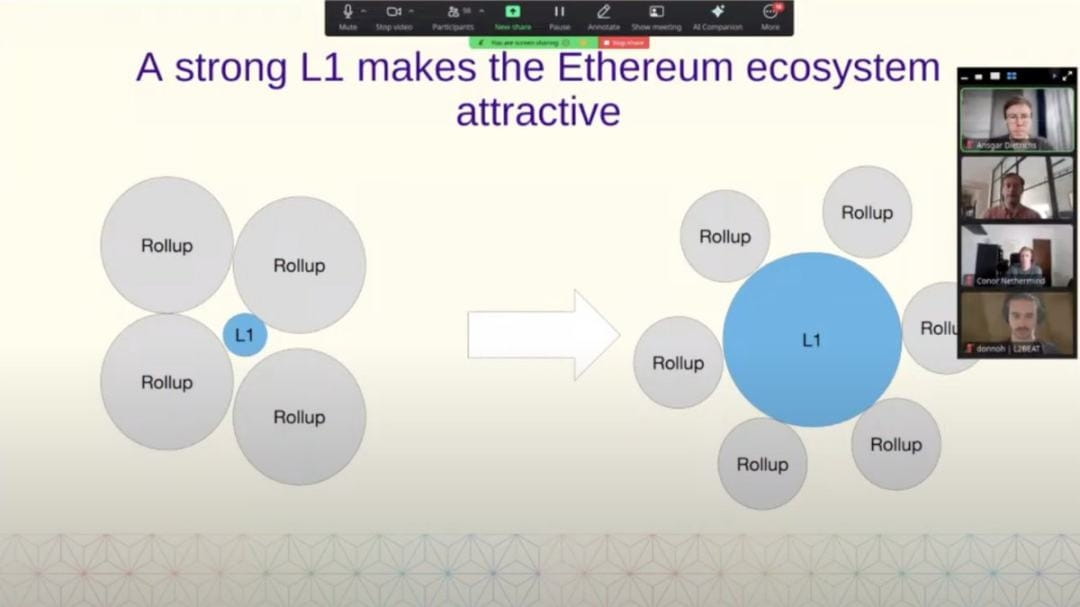
The increased activity on L1 will drive growth in L2 activity, akin to a rising tide lifting all boats.
Source: https://www.youtube.com/live/EvYRiFRYQ9Q?si=bsLWGA6FP9pi2vqI&t=477
The upcoming reconstruction of the Beam Chain consensus mechanism aims to achieve faster final confirmation speeds and lower validator thresholds, while enhancing original throughput and further strengthening Ethereum's neutrality. At the same time, proposals are already considering migrating activities from the increasingly outdated (and 'increasingly complex') Ethereum Virtual Machine (EVM) to a RISC-V native virtual machine, which is expected to significantly improve the efficiency of provers while maintaining interoperability with traditional contracts.
These upgrades will reshape the L2 landscape. By 2030, I expect Ethereum's roadmap centered on general Rollups to integrate in two directions within a range:
Aligned Rollups: Prioritizing deep integration with Ethereum (e.g., shared ordering, native verification) while fully leveraging L1's liquidity under minimized trust assumptions. This relationship is mutually beneficial, as aligned Rollups can obtain composability and security directly from L1.
Performance Rollups: Prioritizing throughput and real-time user experience, sometimes achieving this through alternative data availability layers (DA layers) or authorized participants (such as centralized orderers, small security committees/multi-signatures), but still relying on Ethereum as the final settlement layer for credibility (or for marketing purposes).
When designing these Rollup solutions, each team must weigh the following three aspects:
Liquidity acquisition: How to obtain and use liquidity on Ethereum and possibly other Rollup solutions? How important is synchronous or atomic-level composability?
Source of security: To what extent should liquidity moving from Ethereum to Rollup directly inherit Ethereum's security or rely on Rollup providers?
Execution expressiveness: How important is the compatibility of the Ethereum Virtual Machine (EVM)? Given the rise of alternatives like SVM and popular Rust smart contracts, will EVM compatibility still be important in the next five years?
Polarization on the Rollup spectrum
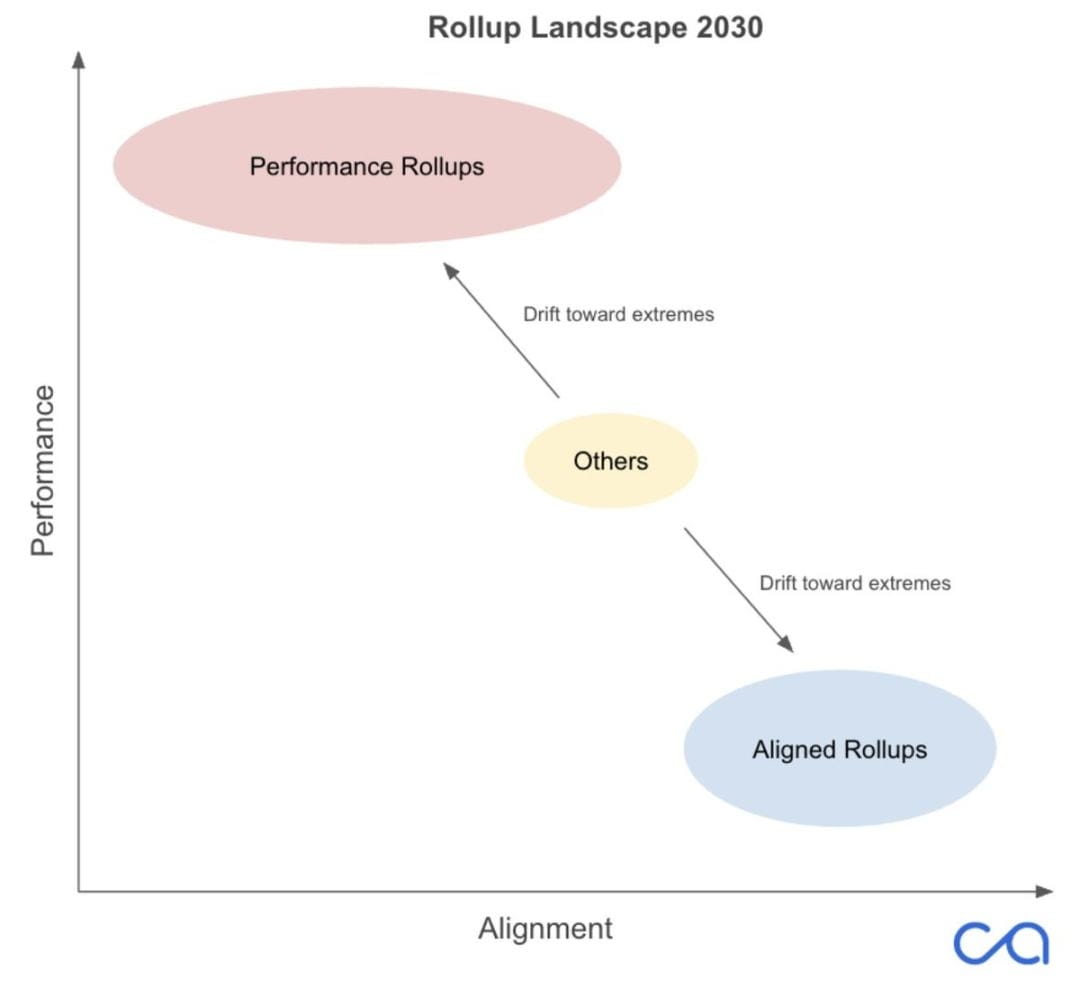
Rollup projects are gradually clustering towards two extremes. On one end are high-performance Rollups, which can provide maximum throughput and user experience (high bandwidth, low latency), but have a lower coupling with Ethereum L1; on the other end are Ethereum-aligned Rollups (such as L1-based Rollups, native Rollups, ultra Rollups, reference link), which fully leverage Ethereum's security, data, and consensus mechanisms, prioritizing decentralization, security, and trusted neutrality, but sacrifice some performance due to L1 design constraints. Rollups in the middle ground, trying to balance both, may struggle to compete and ultimately gravitate towards one of the extremes, facing the risk of elimination.
The Rollups in the upper left corner of the chart focus on performance: they may use centralized orderers, alternative data availability networks (DA networks), or specific application optimizations to achieve throughput far exceeding conventional L2s (such as MegaETH). Some performance-oriented Rollups will align more to the right on the alignment scale (for example, by adopting technologies based on rapid pre-confirmation like Puffer UniFi and Rise, aiming for the 'ideal goal' in the upper right corner), but their final determinism will still depend on the specifications of L1. In contrast, Rollups in the lower right corner maximize alignment with Ethereum: integrating ETH deeply into fees, transactions, and DeFi; solidifying transaction ordering and/or proof verification within L1; and prioritizing composability over raw speed (for instance, Taiko is developing in this direction but is also exploring permissioned pre-confirmation to optimize user experience). By 2030, I expect many 'moderate' L2s will either shift to one of the above patterns or face the risk of being eliminated. Users and developers will tend to choose high-security environments aligned with Ethereum (for high-risk and composable DeFi scenarios) or highly scalable networks tailored for mass user applications. Ethereum's 2030 roadmap lays the groundwork for both paths.
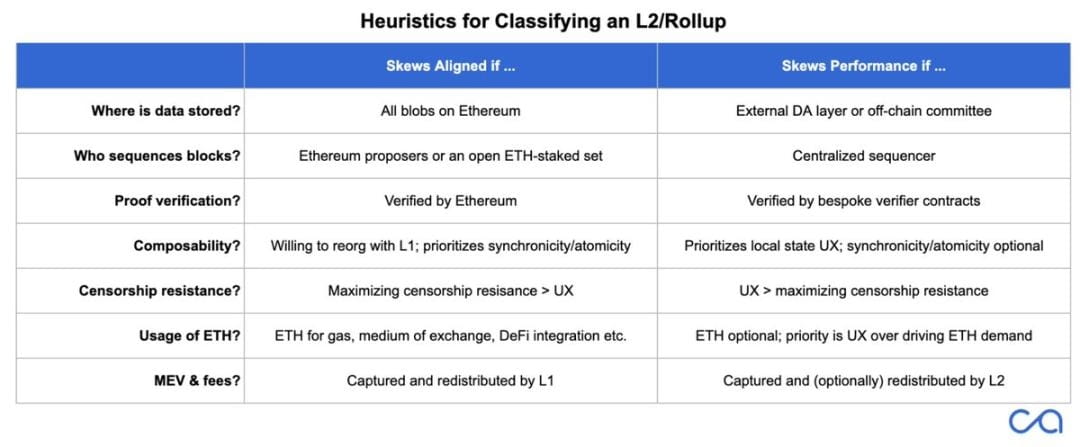
There is controversy over the definition of 'alignment,' and consensus has not yet been reached. For the purposes of this report, the above is a brief analytical framework for 'performance' and 'alignment.' The previous charts were drawn based on this definition and may not apply to other interpretations of 'alignment.'
Why will the middle ground disappear?
Network effects will drive the market towards fewer, larger hubs. In markets where network effects play a dominant role, such as cryptocurrency, a pattern may eventually emerge where a few winners dominate (as we see in the CEX field). Because network effects tend to coalesce around a chain's core advantages, ecosystems often consolidate around a few 'maximizing performance' and 'maximizing security' platforms. A Rollup that achieves only a half-hearted alignment with Ethereum or performance may ultimately gain neither the former's security nor the latter's usability.
As Rollup technology matures, economic activities will form layers based on the trade-off between 'required security' and 'cost of obtaining security.' Scenarios that cannot afford settlement or governance risks—such as institutional-grade DeFi, large on-chain vaults, and high-value collateral markets—may concentrate on chains inheriting Ethereum's complete security guarantees and neutrality (or on Ethereum L1 itself). On the other end, mass-market application scenarios (like memes, trading, social, gaming, retail payments, etc.) will gather on chains offering the best user experience at the lowest cost, requiring customized throughput enhancement solutions or centralized ordering mechanisms. Therefore, 'speed that is acceptable but not the fastest, security that is okay but not optimal' general chains will gradually lose their appeal. Especially by 2030, if cross-chain interoperability allows assets to flow freely between these two types of scenarios, the survival space of this middle ground will be even more limited.
Evolution of Ethereum's tech stack
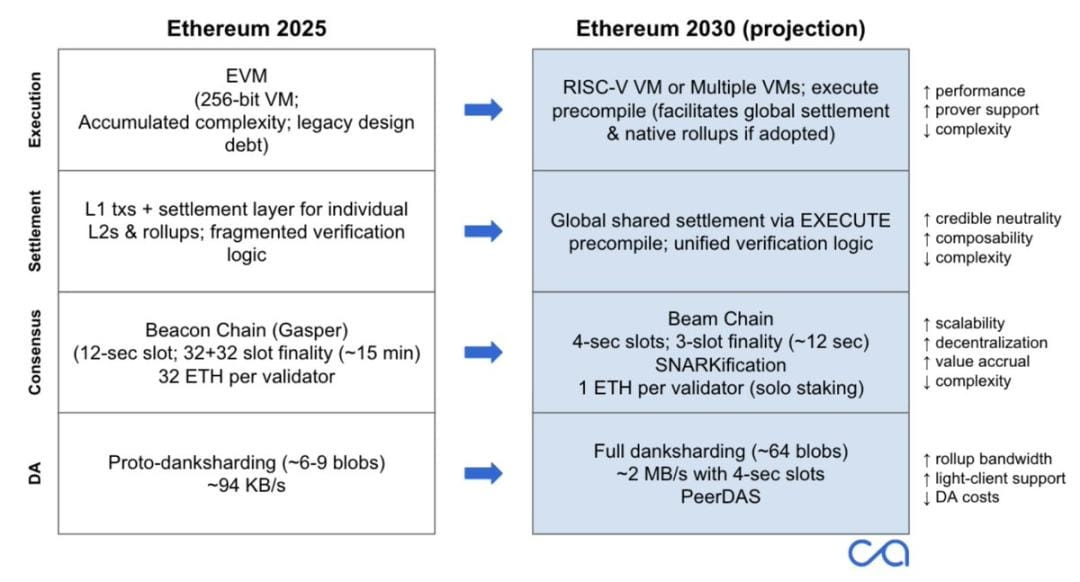
The entire base layer of Ethereum (from execution, settlement, consensus to data availability) is planned for significant upgrades aimed at enhancing L1 scalability and better adapting to the Rollup-centric development model. Key improvements (as indicated by arrows) will enhance performance, reduce complexity, and drive Ethereum to play a more direct role in Rollup operations.
Execution layer
By 2030, Ethereum's current execution environment (using a 256-bit architecture and traditional design with the Ethereum Virtual Machine EVM) may be replaced or enhanced by a more modern and efficient virtual machine. Vitalik has proposed upgrading the Ethereum Virtual Machine to a RISC-V based architecture. RISC-V is a streamlined modular instruction set expected to achieve significant breakthroughs in transaction execution and proof generation efficiency (50-100 times improvement). Its 32/64-bit instructions can directly adapt to modern CPUs and are more efficient in zero-knowledge proofs. To reduce the shock of technological iterations and avoid stagnation (such as the previous dilemma when the community considered replacing EVM with eWasm), a dual virtual machine model is planned: retaining the EVM to ensure backward compatibility while introducing the new RISC-V virtual machine to handle new contracts (similar to Arbitrum Stylus's compatibility solution for WASM + EVM contracts). This aims to significantly simplify and speed up the execution layer while aiding L1's scalability and Rollup support capabilities.
Why do this?
The design of the EVM did not consider zero-knowledge proofs, so zk-EVM provers incur significant overhead when simulating state transitions, calculating root hashes/hash trees, and handling EVM-specific mechanisms. In contrast, the RISC-V virtual machine uses a more streamlined register logic, allowing for direct modeling and proof generation with significantly reduced constraints. Its friendliness to zero-knowledge proofs can eliminate inefficient aspects such as gas calculation and state management, benefiting all Rollups that use zero-knowledge proofs: generating state transition proofs will be simpler, faster, and more cost-effective. Ultimately, upgrading the EVM to a RISC-V virtual machine can enhance overall proof throughput, making L1 direct verification of L2 execution possible (as detailed below), while increasing the throughput ceiling of performance-oriented Rollups' own virtual machines.
In addition, this will also break through the niche of Solidity/Vyper, significantly expanding Ethereum's developer ecosystem and attracting more participation from mainstream development communities like Rust, C/C++, and Go.
Settlement layer
Ethereum plans to shift from fragmented L2 settlement models to a unified, natively integrated settlement framework, which will fundamentally change how Rollups are settled. Currently, each Rollup must deploy independent L1 verification contracts (fraud proofs or validity proofs), which are highly customized and independent of one another. By 2030, Ethereum may integrate a native function (the proposed EXECUTE precompiled function) as a universal L2 execution validator. EXECUTE allows Ethereum validators to directly re-execute the state transitions of Rollups and verify their correctness, essentially 'cementing' the ability to validate any Rollup block at the protocol level.
This upgrade will give rise to 'native Rollups', essentially programmable execution sharding (similar to NEAR's design). Unlike ordinary L2s, standard Rollups, or L1-based Rollups, the blocks of native Rollups are verified by Ethereum's own execution engine.
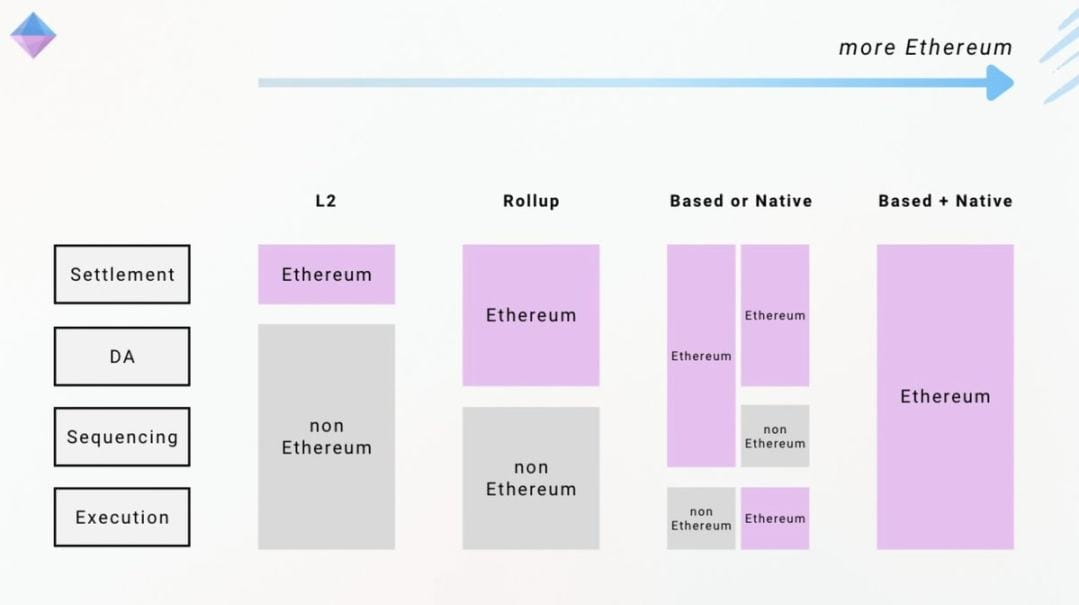
Source: https://x.com/Spire_Labs/status/1915430799618564394
EXECUTE eliminates the complex custom infrastructure needed for simulating and maintaining the EVM (such as fraud proof mechanisms, zero-knowledge proof circuits, multi-signature 'security committees'), greatly simplifying the development of equivalent EVM Rollups, ultimately achieving a completely trustless L2 with almost no custom code required. Combined with next-generation real-time provers (such as Fermah, Succinct), real-time settlement can be achieved on L1: once Rollup transactions are included in L1, they achieve finality without waiting for fraud proof windows or multi-period proof calculations. By building the settlement layer as a globally shared infrastructure, Ethereum enhances trusted neutrality (users can freely choose verification clients) and composability (without worrying about real-time proof issues in the same slot, synchronous composability is greatly simplified). All native (or native + L1-based) Rollups will use the same L1 settlement function, enabling standardized proofs and convenient interactions between Rollups (sharding).
Consensus layer
Ethereum's Beacon Chain consensus layer is being restructured into Beam Chain (planned for testing in 2027-2029), aiming to upgrade the consensus mechanism through advanced cryptographic technology (including quantum resistance) to enhance scalability and decentralization. Among the six major research directions for upgrades, the core features relevant to this article include:
(The latest progress of Beam Chain can be learned through the 'Beam Call' series on YouTube.)
Shorter slots, faster finality: One of the core goals of Beam Chain is to enhance finality speed. Reducing the current approximately 15 minutes of finality (2 epochs under the Gasper mechanism, i.e., 32+32 twelve-second slots) to 3-slot finality (3SF, 4-second slots, about 12 seconds), ultimately achieving single-slot finality (SSF, about 4 seconds). 3SF + 4-second slots mean that transactions can achieve final confirmation within 10 seconds after being on-chain, greatly improving the user experience for L1-based Rollups and native Rollups: the increased speed of L1 blocks will directly accelerate Rollup block generation. The time for transactions to be included in blocks is about 4 seconds (longer under high load), increasing the block speed of relevant Rollups by 3 times (although still slower than performance-oriented Rollups or alternative L1 or credit card payments, so pre-confirmation mechanisms remain very important). Faster L1 finality will also ensure and accelerate settlement: Rollups can complete final confirmations of state submissions on L1 within seconds, enabling rapid withdrawals and reducing risks of reorganization or forks. In short, the irreversibility of Rollup transaction batching will be reduced from 15 minutes to seconds.
Reducing consensus overhead through SNARKs: Beam plans to 'SNARKify' the state transition functions, allowing each L1 block to come with a succinct zk SNARK proof. This is a prerequisite for achieving synchronous, programmable execution sharding. Validators can verify blocks and aggregate BLS signatures (and future quantum-resistant signatures) without processing each transaction, significantly reducing the computational costs of consensus (while also lowering the hardware requirements for validators).
Lowering the staking threshold to enhance decentralization: Beam plans to reduce the minimum staking amount for validators from 32 ETH to 1 ETH. Combined with proposer-prover separation (APS, moving MEV to on-chain auctions) and SNARKification, this will allow for distributed anti-collusion block construction, no longer favoring scaled staking pools (such as Lido with a 25% market share), and instead supporting more independent stakers using devices like Raspberry Pi. This will enhance decentralization and trusted neutrality, directly benefiting aligned Rollups. Under the APS mechanism, the number of proposers will decrease, but the inclusion list (FOCIL) will strengthen censorship resistance: once a prover lists a transaction, even a small, globally distributed group of proposers cannot exclude those transactions.
All of this points to the future of Ethereum's base layer: it will possess stronger scalability and decentralization. In particular, L1-based Rollups will benefit the most from these consensus upgrades, as L1 will better adapt to their transaction ordering needs. By sorting transactions on L1, the maximum extractable value (MEV) from L1-based Rollups (and native L1-based Rollups) will naturally flow to Ethereum block proposers, and this value can be destroyed, thereby concentrating more value back into ETH rather than flowing to centralized orderers.
Data availability layer (DA layer)
Data availability (DA) throughput is key to Rollup expansion, especially for future performance-oriented Rollups that need to support over 100,000 TPS. Ethereum's Proto-danksharding (Dencun + Pectra upgrade) has already increased the target and maximum number of blobs per block to 6 and 9, respectively, achieving a blob data capacity of approximately 8.15 GB/day (about 94 KB/s, 1.15 MB/block), but it is still insufficient. By 2030, Ethereum may achieve complete danksharding, targeting 64 blobs per block (each 128 KB), which would correspond to about 8 MB/4-second slot (2 MB/s).
(Note: Proto-danksharding is a key technological upgrade in Ethereum's scalability roadmap, significantly enhancing network performance by introducing new data storage mechanisms. It is a transitional solution to Danksharding, with the core goal of reducing transaction costs and enhancing data availability for L2 solutions while laying the groundwork for future full sharding technology.)
Although this is a tenfold improvement, it still cannot meet the demand of performance-oriented Rollups like MegaETH for ~20 MB/s. However, Ethereum's roadmap includes more upgrades: achieving data availability sampling (DAS) through solutions like PeerDAS (expected in the second half of 2025 - first half of 2026), allowing nodes to verify availability without downloading complete data, and combining data sharding to increase the target for each block blob to 48+. Under ideal Danksharding and DAS support, Ethereum could achieve a processing capacity of 16 MB of data in a 12-second slot, corresponding to about 7,400 simple transactions per second, which could reach 58,000 TPS after compression (such as aggregated signatures and address compression). Combined with Plasma or Validium (only on-chain state roots rather than complete data), even higher rates could be achieved. Although off-chain expansion poses trade-offs between security and scalability (such as operator negligence risks), by 2030, Ethereum is expected to offer diversified DA options at the protocol layer: providing full on-chain data assurance for security-focused Rollups and flexible external DA access for scale-focused Rollups.
In summary, Ethereum's data availability (DA) upgrades are making it increasingly suitable for Rollups. However, it is important to note that Ethereum's current throughput is still far from sufficient to support high-frequency scenarios like payments, social, and gaming. Even a simple ERC-20 transfer requires about 200 bytes of blob data; rough calculations indicate a need for about 20 MB/s of raw DA bandwidth; while more complex transactions (like Uniswap swaps) will produce larger state differences, raising the required bandwidth to about 60 MB/s! Relying solely on complete Danksharding technology will not meet these bandwidth requirements; thus, throughput improvements must rely on clever combinations of data compression and off-chain expansion.
In the meantime, performance-oriented Rollups will need to rely on alternative DA solutions like Eigen DA. These solutions currently provide about 15 MB/s throughput and plan to increase it to 1 GB/s; emerging solutions like Hyve even promise to achieve modular DA of 1 GB/s and support sub-second availability. It is these DA solutions that can equip Web3 applications with speeds and user experiences comparable to Web2.
The vision of Ethereum's world ledger
'Ethereum aims to become the world ledger: a platform for storing human civilization's assets and records, serving as the foundational layer for finance, governance, high-value data certification, and more. This requires two core capabilities: scalability and risk resistance.' - Vitalik
By 2030, with core protocol upgrades and the evolution of Rollup-centric technology, Ethereum will be better suited to this role. As mentioned earlier, upgrades across the entire tech stack will support two types of Rollup models: one leaning towards 'deep Ethereum integration', focusing on security and trusted neutrality; the other leaning towards 'light Ethereum integration', aiming for extreme throughput and economic independence. Ethereum's roadmap does not enforce a single path, but provides sufficiently flexible soil for both models to thrive.
Aligned Rollups: Ensuring that high-value, highly relevant applications continue to receive Ethereum's strong security assurance. Among these, L1-based Rollups can achieve Ethereum-level liveness, with L1 validators responsible for transaction ordering while generating Rollup blocks; native Rollups possess Ethereum-level execution security, with every Rollup state transition re-executed and verified on L1; while native L1-based Rollups (or ultra Rollups, i.e., execution sharding) combine 100% execution security with 100% liveness, effectively becoming part of Ethereum L1. These Rollups will drive value accumulation for Ethereum L1: the MEV (maximum extractable value) generated by L1-based Rollups flows directly to Ethereum validators, and through MEV destruction mechanisms can enhance ETH's scarcity; invoking the EXECUTE precompiled function to verify proofs of native Rollups incurs gas costs, creating new value influx channels for ETH. If the majority of DeFi and institutional finance operates on a few aligned Rollups in the future, ETH will capture the fees of the entire economy. Ethereum's anti-censorship capabilities and MEV value capture mechanisms are two key pillars for it to become the 'world ledger'.
Performance Rollups: Enabling the Ethereum ecosystem to cover a full range of blockchain applications, including scenarios requiring large-scale processing capabilities. These chains are likely to become mainstream adoption bridges, even though they may introduce (semi) trust elements, they still rely on Ethereum as the final settlement layer and interoperability hub. The coexistence of performance-oriented and aligned Rollups allows the Ethereum ecosystem to support both top-level security and top-level throughput applications. The heterogeneity and interoperability of L2 is more beneficial than detrimental for Ethereum: although these Rollups have weaker economic ties to ETH, by using ETH as a gas token, transaction medium, DeFi pricing unit, and core asset for new applications in high-capacity environments, they can still create additional demand for ETH. Notably, the previously mentioned Ethereum DA layer may support over 100,000 TPS, which means that even if performance-oriented chains ultimately return to the Ethereum DA layer, rather than relying on modular alternatives (for ecological synergy, trusted neutrality, simplification of the tech stack, etc.), they still can choose other DA solutions if they need to save costs or improve performance, but the core point is: progress in Ethereum's DA layer, data compression, and off-chain data management will continue to enhance L1's competitiveness.
Exceptional cases mainly involve Rollups that are deeply tied to trusted enterprises (such as Coinbase's Base and Robinhood's L2 network Robinhood Chain), where users trust these enterprises more than trustless systems (this effect is particularly pronounced among new users and non-technical users). In this case, the reputation and accountability mechanisms of the associated enterprises become the primary guarantees, allowing these Rollups to remain competitive while weakening Ethereum's alignment, as users are willing to 'trust brands' like they do in Web2. However, their adoption largely depends on B2B trust, for example, JPMorgan Chain may trust Robinhood Chain more than Ethereum and the stronger assurances provided by aligned Rollups.
Moreover, the integration of Rollups in the middle ground is likely a natural result of the maturity of these two paths. The reason is simple: middle-ground solutions can neither achieve high alignment nor reach top performance. Users focusing on security and composability will choose Rollups closer to Ethereum; while users valuing low cost and high speed will lean towards optimal performance platforms. Additionally, as pre-confirmation technologies advance, slot speeds increase, and L1 finality accelerates, the performance of aligned Rollups will continue to improve, further diminishing the demand for 'moderate performance'. Overall, the former is more suitable for institutional DeFi, while the latter is better for retail-level applications.
Successful Rollups require a significant investment of resources (from attracting liquidity to maintaining infrastructure). By 2030, integrations will be more frequent, with strong networks absorbing the communities of weaker networks. This trend is already visible. In the long run, an ecosystem composed of a few core hubs with clear value propositions will outperform hundreds of homogeneous systems.
Special thanks to mteam, Patrick, Amir, Jason, Douwe, Jünger, and Bread for their valuable discussions and feedback!






